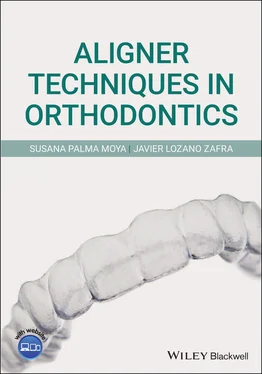1 Cover
2 Title Page
3 Copyright Page
4 Preface
5 About the Authors
6 Acknowledgements
7 About the Companion Website
8 1 History, Present and Future of Aligners1.1 History of Clear Aligners 1.2 Origins of Align Technology 1.3 Early Clear Aligner Manufacturers 1.4 Align Technology Development 1.5 Current Situation and Future of Aligners 1.6 Promising Aligner Initiatives 1.7 Future of Clear Aligners
9 2 Basic Principles with Aligners 2.1 Forces 2.2 Engagement 2.3 Anchorage 2.4 Case Selection to Start with Aligners Technique
10 3 Why Invisalign? 3.1 Why Did We Begin Prescribing Invisalign in Our Practice? 3.2 Our Motivation
11 4 Patient Communication Skills 4.1 Invisalign Equates to Health, Wellness and Outstanding Results 4.2 Effective Patient Communication
12 5 Keys to Practice Growth 5.1 How to Get the Best Results with Invisalign
13 6 Patient Selection
14 7 Predictability of Movement 7.1 Treatments to Gain Familiarity with the Technique
15 8 Types of Treatments with Invisalign
16 9 Pillars of the Invisalign Technique 9.1 Aligners 9.2 ClinCheck Software 9.3 Attachments and Features of SmartForce 9.4 Auxiliary Techniques 9.5 Technician (CAD Designer)
17 10 Conventional Attachments
18 11 Clinical Preferences
19 12 Attachments Bonding and Interproximal Reduction12.1 Bonding Attachments Protocol 12.2 Interproximal Reduction Procedure
20 13 Digital Workflow 13.1 Records 13.2 Creating a New Patient Record
21 14 ClinCheck Software 14.1 The Perfect ClinCheck Review in 10 Steps 14.2 Communication with the Technician
22 15 Treatment Monitoring and Appointments Protocol 15.1 Tracking Treatment Progress 15.2 Appointments Protocol for Invisalign Patient
23 16 Troubleshooting and Retention 16.1 Auxiliary Techniques 16.2 Finishing Techniques 16.3 Retention
24 17 Arch Length Discrepancies 17.1 Spacing 17.2 Crowding
25 18 Growing Patients 18.1 First Treatment 18.2 Teenage Patients
26 19 Transversal Problems: Symmetric and Asymmetric Expansion 19.1 Things to Consider in Expansion Cases 19.2 Symmetric Expansion 19.3 Asymmetric Expansion 19.4 Tips for Transversal Arch Compensation
27 20 Sagittal Discrepancies 20.2 Class II Cases 20.3 Class III 20.4 Dentoalveolar Protrusion Skeletal Class II
28 21 Vertical Problems21.1 Open Bite 21.2 Deep Bite: Classification According to Complexity Bibliography
29 22 Asymmetries 22.1 Growing Patients with Asymmetry 22.2 Non‐growing Patients with Asymmetry
30 23 Extraction Cases23.1 Incisor Extraction 23.2 Extraction of Premolars
31 24 Multidisciplinary Cases: Implants24.1 TADs to Intrude Upper Molars 24.2 Upper Midline Shift 24.3 Posterior Bite Collapse 24.4 Posterior Bite Collapse with Deep Bite 24.5 Biomechanics of the Locatelli for Mesialization of the Lower Dental Arch Opening Space for Implants 24.6 Gingivectomy, Passive Eruption Case 24.7 Anterior Intrusion Anchored on Dental Implant 24.8 Anterior Torque Anchored on Dental Implant
32 25 Prerestorative Orthodontics: Veneers 25.1 Bleaching 25.2 Veneers to Solve Lateral Bolton Discrepancy in a Class III Patient 25.3 Space Opening for Anterior Crowns and Implants 25.4 Anterior Intrusion for Two Central Incisor Veneers 25.5 Edge‐to‐Edge Bite Preparation for Veneers
33 Index
34 End User License Agreement
1 Chapter 20Table 20.1 Extra resources for class II patientsTable 20.2 Protocol when treating a growing patient with class II
1 Chapter 1 Fig. 1.1 Remensnyder patent file. Fig. 1.2 Kesling patent file. Fig. 1.3 Schwartz and Sheridan patent file. Fig. 1.4 Align Technology logo. Fig. 1.5 Align Technology annual revenue. Fig. 1.6 Align Technology stereolithographic has been heavily awarded. Fig. 1.7 Models and aligners by Clear Correct. Fig. 1.8 Optimized attachments for anterior open bite. Fig. 1.9 Passive attachments for anterior intrusion. Fig. 1.10 Results in PubMed for ‘orthodontics’. Fig. 1.11 Results in PubMed for ‘invisalign’ from 1999 to 2019. Fig. 1.12 ClearCorrect aligner retention chart. Fig. 1.13 SureSmile aligner software combined with CBCT. Fig. 1.14 F22 chromatic stability. Fig. 1.15 3M superimposition for treatment evolution. Fig. 1.16 Ormco results for their TruGEN plastic against SmartTrack (data on fil... Fig. 1.17 Distalizer inserted in an in‐practice aligner. Fig. 1.18 Irok is focused on digital models that can serve different purpose...Fig. 1.19 A6 mandibular advancement launched in 2015.Fig. 1.20 LineDock software.Fig. 1.21 SmileDirectClub self‐polyvinyl siloxane (PVS) ‐impression kit.Fig. 1.22 CANDID aligners process.Fig. 1.23 CANDID aligners set.
2 Chapter 2Fig. 2.1 Forces will be delivered through the combination of plastic and att...Fig. 2.2 Optimized attachments provide an active, flat surface that the alig...Fig. 2.3 These crowns allow enough contact from plastic to exert desired for...Fig. 2.4 Short clinical crowns might reduce movement predictability.Fig. 2.5 Quantification of variable aligner material on retention. (Left) Ve...Fig. 2.6 Brackets have a strong small contact point in comparison with a sof...Fig. 2.7 While second molars are moving, the rest of the teeth are considere...Fig. 2.8 This figure shows a horizontal ‘V’ movement pattern.Fig. 2.9 The second quadrant is being expanded using the first quadrant as a...Fig. 2.10 G6 first premolar extraction has a standardized movement sequence....Fig. 2.11 In this G6 protocol extraction of 14 (from left to right), the pos...
3 Chapter 4Fig. 4.1 Let’s talk about aligner treatment with our patients.Fig. 4.2 The more Invisalign patients you have, the more Invisalign referral...Fig. 4.3 A treatment coordinator is a key success driver for Invisalign.
4 Chapter 5Fig. 5.1 If we plan our growth in advance, we will reach our goals.
5 Chapter 6Fig. 6.1 Invisalign evaluation tool.
6 Chapter 7Fig. 7.1 All treatment predictability can be checked with the Invisalign eva...
7 Chapter 8Fig. 8.1 Align Technology’s 2021 portfolio
8 Chapter 10Fig. 10.1 Ellipsoid attachments. Fig. 10.2 Horizontal attachments have great clinical effects on transverse p...Fig. 10.3 Conventional attachments are selected whenever there are no optimi...Fig. 10.4 Extrusion attachments are placed on teeth adjacent to the ones to ...Fig. 10.5 Vertical attachments bevelled to mesial (left) and distal (right)....Fig. 10.6 Conventional attachments might be placed to achieve similar moveme...Fig. 10.7 Research and development investment has led to a very powerful bio...Fig. 10.8 Conventional dental composite is the material chosen for attachmen...Fig. 10.9 Placement on canines and premolars. Fig. 10.10 Placement on incisor. Fig. 10.11 Placement on premolar.Fig. 10.12 The right side shows how anterior extrusion attachments help to c...Fig. 10.13 The figure on the right shows how optimized root control attachme...Fig. 10.14 Pressure points are usually associated with attachments whenever ...Fig. 10.15 Combination of attachments and lingual pressure points help creat...Fig. 10.16 Sometimes attachments are designed for support instead of movemen...Fig. 10.17 Attachments for molars are relatively new and provide improved ro...Fig. 10.18 Mesiobuccal rotation combined with extrusion.Fig. 10.19 Mesiobuccal rotation combined with intrusion.Fig. 10.20 Molar extrusion. Fig. 10.21 Optimized support attachments are commonly used in first treatmen...Fig. 10.22 Power Ridges are plastic bends exerting ‘push’ forces.Fig. 10.23 Activation exerts forces translated to crown or root.Fig. 10.24 Effect of pressure point on the tooth.Fig. 10.25 Precision Ramps are much comfortable for the patient than convent...Fig. 10.26 Clinical view of Precision Wings in a growing patient.
Читать дальше












